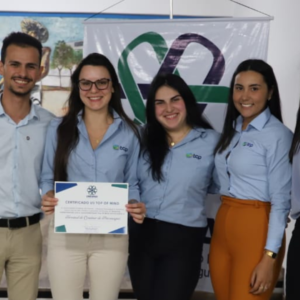Acquisition of 11 RTGs should be responsible for 65 of the 100 new jobs for operators that will be opened by the end of 2023
On Wednesday 22nd, the Paranaguá Container Terminal (TCP) received 11 new RTGs (Rubber Tyred Gantry). The cranes left China for Paranaguá on October 8 and were transported already assembled on board the ship. With the acquisition of the equipment, 65 new jobs will be created for transshipment operators.
There will also be 35 new vacancies for operators of Terminal Tractors (TTs), equipment used to transport containers between ship, yard, warehouse and railroad. The purchase was signed in August and TCP has acquired 17 new TTs, which are expected to arrive in December.
“The opening of 100 new jobs for operators comes to meet our operational and logistical demand, guaranteeing an increase in productivity for the terminal and offering more opportunities for the people of Paraná,” says Washington Bohnn, TCP’s human resources and quality manager. The terminal is currently Paranaguá’s largest employer and has more than 1,400 employees.
TCP’s purchase of the new RTGs and TTs is part of a R$370 million investment package, which should be completed by the end of this year. Among the projects already completed are the electrification of two RTGs operating on the railway line, the construction of a new GIS (gas insulated substations) model power substation, among others.
Considered to be the largest frozen chicken export corridor in the world, TCP is also due to complete the expansion of the number of sockets in its reefer yard by the end of 2023, from 3,572 to 5,126, increasing its area for storing temperature-controlled containers.
State-of-the-art RTGs and TTs
The 11 new RTGs acquired by the terminal are manufactured by the Chinese company ZPMC. They have a lifting height of 21.2 meters, allowing a stacking capacity of 6+1, and can lift 41 tons. “With the new equipment, the number of RTGs at TCP has risen from 29 to 40, a substantial increase of 38% in our fleet of transtainers, which will ensure an increase in productivity and greater reliability in the rear of the ship’s operation,” explains TCP’s maintenance manager, Fernando Henrique Carneiro Reis.
The RTGs are also equipped with new safety technologies, such as laser stack mapping and an anti-truck lift system, which prevents accidents in cases where the container gets stuck in the body of a truck.
The new TTs, model KT2i 4×2, manufactured by the Polish company Kalmar, have the capacity to carry up to 85 tons of cargo and have an autonomy of three days of uninterrupted operations, double the working period of the vehicles in use at the terminal. “Upgrading TCP’s fleet of Terminal Tractors will bring more efficiency to the terminal’s operations, as well as ensuring greater safety for our employees,” explained operations and safety superintendent Nicolas Wang.
The vehicles purchased by TCP have protection systems (ROPS and FOPS) and structural reinforcements in the cab, which ensure greater safety for employees. In addition, the models offer greater comfort and ergonomics for drivers, thanks to cabs with ample visibility, adjustable seats and pneumatic cushioning. The cab’s electric lift also facilitates maintenance services. In addition to purchasing the TTs, TCP intends to buy a further 27 terminal trailers (semi-trailers) to complement its fleet.



